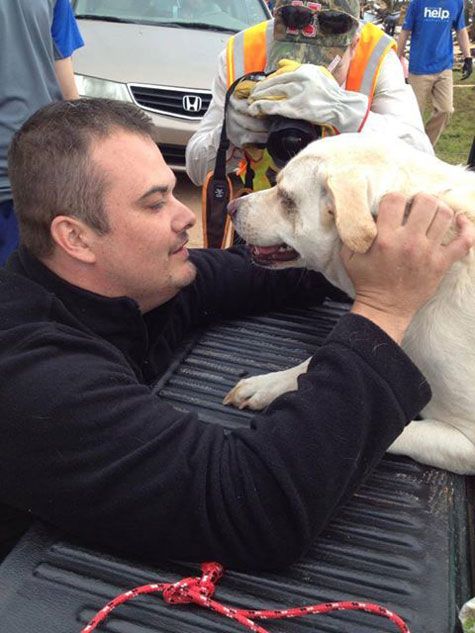Microchips, social media crucial after Oklahoma tornado
The ability to obtain contact information speeds reunions for displaced pets and owners.

A man is reunited with his dog after the May 20 tornado that severely damaged much of Moore, Okla.
Photo couresy of Meeker Animal Hospital
When the record-breaking EF-5 tornado tore through the heart of Moore, Okla., the afternoon of May 20, many pets were home alone, their owners not yet back from work. “If they weren’t in arm, they were pretty well dispersed,” says Leslie Cole, DVM, chair of the disaster issue committee with the Oklahoma Veterinary Medical Association.
Countless pets were missing and feared dead in the storm’s aftermath. Winds up to 200 mph had battered animals with debris and tossed them like ragdolls. The safety of shelter disappeared as structures crumbled around them. Many terrified pets simply bolted. “Dogs and cats scatter to the four winds” during a storm, Cole says. “In the previous big tornadoes, dogs showed up 10 miles from home two weeks later.”
Pets that were lost, injured, trapped, traumatized--and often without identification--were found amongst the rubble by veterinary practitioners, volunteers and residents. The McClain County Animal Response Team (McCART) processed 102 animals in the first 24 hours.
As the number of displaced pets mounted, emergency shelters were created and a process put in place to reunite pets with owners. “The animals were found, triaged and sent to the most appropriate receiving station,” Cole says. “There they were photographed and put on the Facebook page.”
Facebook pages were created for triage centers and shelters, then populated with images of dogs and cats. “Back in ’99 we didn’t have Facebook like we have now,” says Dustin Brown, DVM, owner of two veterinary clinics not far from Moore. “I’m so pleased with how many pets are finding their owners so quickly.”
Brown says volunteers were often able to reunite pets with their owners more quickly if pets had microchips. All animals were scanned as soon as they were received at the shelters.
Brown’s receptionist found only her dog’s broken crate after the storm--no sign of her dog at all. Then she got a phone call that her pet was alive and well with just a minor laceration on her leg.
Brown wishes more pets were microchipped. “The importance of microchipping really paid off,” he says. He plans to run a special on microchipping at his clinics to encourage more people to do it.
Kristi Scroggins, DVM, owner of Scroggins Animal Hospital in Moore, was thrilled when the American Kennel Club donated microchips for the recovery effort the Cleveland County Fair Grounds emergency shelter. “Everyone taken in is microchipped,” she says.
Brown says the combined resources of microchipping and social media have proved far more successful than in previous tornadoes. “The reuniting is going quicker than I expected with Facebook and the Internet,” he says. “It’s just one right after the other getting back with their owners. It makes it all worthwhile.”
Of course, there are still plenty more pets still waiting to be reunited. So those manning the shelters continue to call numbers scanned from microchips and post pictures of fuzzy faces on Facebook with the hope that every surviving pet will go home again. “It’s amazing to watch people who are separated from their pets,” Brown says. “They don’t care about all they’ve lost. It makes it all better when their pets are fine.”
2 Commerce Drive
Cranbury, NJ 08512
All rights reserved.